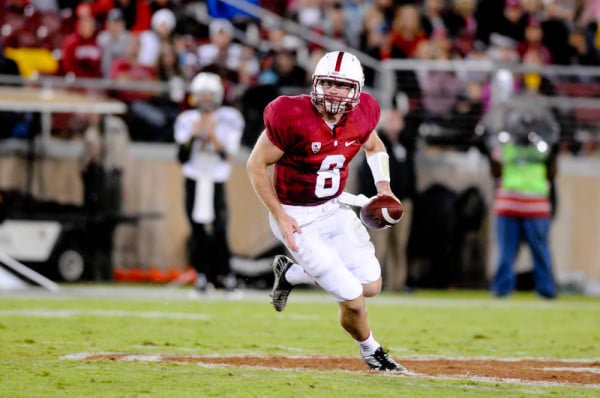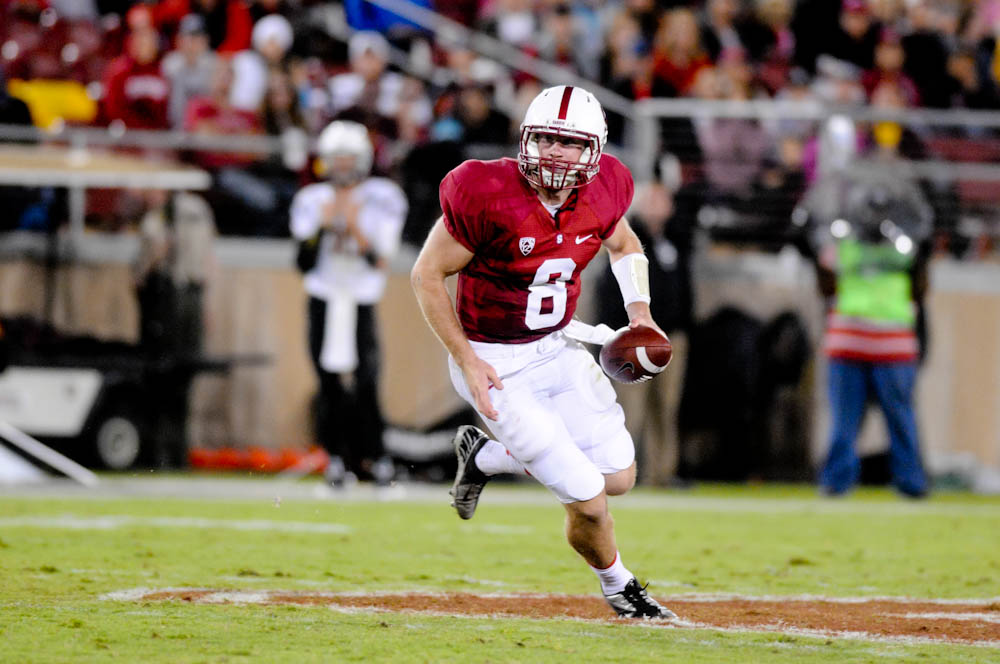Coming into the 2013 season, most people figured that with Kevin Hogan’s increased experience and the emergence of young wide receivers, Stanford’s offense was going to improve dramatically. After showing signs of improvement early in the season, the Cardinal offense has sputtered over its past few games. We asked football writers Do-Hyoung Park, David Cohn and Winston Shi: Is Stanford’s offense better now than it was going into the Oregon game last season?

Do: At the beginning of the season, I would have said a wholehearted yes. The exhilaration of finally seeing Stanford develop a consistent deep passing game that could quickly put up points was a huge facelift for the offense and seemed like it could be the x-factor that would finally push the team over the edge. And for the first time since the Andrew Luck ‘12 days, I was just as excited — if not more so — to see Stanford’s offense on the field as I was to see the defense.
But as the saying goes, “be careful what you wish for.” As the weeks progressed, a distressing trend emerged: With the advent of Stanford’s passing game, many felt that Stanford was starting to drift away from its identity as a primarily power-run team. Instead of mercilessly plowing ahead on short-yardage downs, we’ve been seeing Shaw try and get more creative with his play calling, likely based at least in part to his increased confidence in the passing game.
Because of that loss of identity, the offense has been stagnating at inopportune times, and was even unable to move the ball consistently on an Oregon State defense that was gashed to the tune of 49 points by an FCS team. The offense has been in a funk for the last few games and is limping into the Oregon matchup on a severe down note after a hot start to the season. Meanwhile, last year, the offense was coming into the Oregon matchup on a high after the revelation of junior Kevin Hogan at quarterback following the inconsistency of Josh Nunes ‘13. The offensive momentum is going completely in the wrong direction, and although this year’s offense is statistically better, its mojo seems to be gone.
David: Stanford’s offense is better this year than it was at this point last season, because I believe Hogan is better this season. While Hogan’s completion percentage is down this year, he is being asked to do a lot vertically in order to open up running lanes for Tyler Gaffney. While I have heard a lot people say that Stanford just needs to hand the ball off to Gaffney on seemingly every down, a power running game’s success is contingent upon the threat of the downfield pass. Otherwise, Oregon would employ Notre Dame’s strategy from last season of stacking the box to stifle Gaffney.
As such, if Stanford hopes to beat the Ducks this season, Hogan has to hit his wide receivers consistently down the field. Fortunately for Stanford, Hogan has shown that he is more than capable of rising to this challenge with the help of playmakers in junior wide receiver Ty Montgomery, sophomore wideout Kodi Whitfield and, when he is healthy, junior wideout Devon Cajuste (see Arizona State, Washington State and UCLA, among other examples).
However, since memories appear to be so short-lived sometimes, and struggles in hostile road environments and against quality defensive coordinators are magnified (see Justin Wilcox), the Cardinal has regressed and has “lost its mojo”. Personally, I don’t understand how an offense can be statistically better in most offensive categories, including points per game (32.6 versus 27.9), rushing yards per game (196.4 versus 174.3) and yards per play (6.2 versus 5.5), but somehow be worse than last year’s unit.
In addition, each game is its own entity, so we do not know how the offense will perform against Oregon. For example, Stanford’s 2011 offense seemingly destroyed every opponent in its wake, before playing a poor game against the Ducks. In that case, momentum did not matter at all.
Winston: At the risk of hurting David’s feelings, I’m going to step into the fray now and call Mr. Cohn out for his sarcasm. Do has a reasonable point in that Stanford’s offense has not been as effective as we know it can be. The downfield passing game is inconsistent, and especially so since Cajuste’s injury, while the run game is consistent but inconsistently used. More than anything, Stanford seems interested in playing to the level of its opponent — and at times, it seems, by design. Why open up the playbook if you don’t need to?
David’s use of yards per play stats is wrong. Football rewards consistency, not yardage. Teams need to complete drives above anything else. Let’s imagine a scenario in which Stanford only throws 99-yard Hail Marys and completes them 10 percent of the time. 9.9 yards per play would be the “best” offense in the country, but the offense would only score about a quarter of the time, or about 20 points per game — and that’s if the offense never turned the ball over or gave up any sacks.
Consistency and long drives keep the offense on the field, which allows the defense to rest. The run game is consistent; that is why it is important. Even if it doesn’t run as much, Stanford is winning. That said, things are not all well with the Stanford offense.
But I can understand why Stanford is going to the passing game. As Stanford faces better defenses later in the year, growing pains are to be expected, but without Hogan testing his limits and learning to run the classic Cardinal playbook, Stanford’s offense will never reach its full potential. If Hogan can’t make Oregon pay for stacking the box against the run, the Ducks will be kings of the West.
After that smackdown, suggest some burn ointment for David Cohn at dmcohn ‘at’ stanford.edu and help Winston Shi find a lawyer for the inevitable lawsuit from David’s family at wshi94 ‘at’ stanford.edu. Oh, and if conflict isn’t your thing, contact the third party Do-Hyoung Park at dpark027 ‘at’ stanford.edu.
